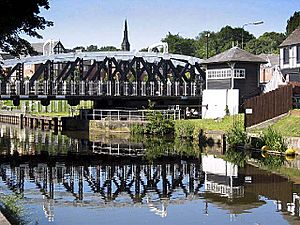Holy Trinity Church, Northwich facts for kids
Quick facts for kids Holy Trinity Church, Northwich |
|
|---|---|

The spire of Holy Trinity Church from Town Bridge
|
|
| Lua error in Module:Location_map at line 420: attempt to index field 'wikibase' (a nil value). | |
| OS grid reference | SJ 655 735 |
| Location | Northwich, Cheshire |
| Country | England |
| Denomination | Anglican |
| Website | Holy Trinity, Northwich |
| History | |
| Status | Parish church |
| Founded | 1 July 1841 |
| Founder(s) | Weaver Navigation Trustees |
| Consecrated | 1 July 1842 |
| Architecture | |
| Functional status | Active |
| Heritage designation | Grade II |
| Designated | 19 August 1986 |
| Architect(s) | Edmund Sharpe |
| Architectural type | Church |
| Style | Gothic Revival |
| Groundbreaking | 1841 |
| Completed | 1842 |
| Administration | |
| Deanery | Middlewich |
| Archdeaconry | Chester |
| Diocese | Chester |
| Province | York |
Holy Trinity Church, Northwich, is a beautiful old church located in the Castle area of Northwich, England. It's also sometimes called Holy Trinity Church, Castle. This church is part of the Anglican faith and is still an active place of worship today. It's considered an important historical building, listed as Grade II, which means it's protected because of its special history and architecture. Until 2018, it was linked with St Luke's Church in Winnington, but now it is its own parish again.
Contents
History of the Church
Why the Church Was Built
In the 1700s, people made the River Weaver better for boats. This helped transport salt from mines in Cheshire to the River Mersey. This improved waterway was called the Weaver Navigation.
By 1839, the people who worked on the Weaver Navigation asked for a day off. They wanted to rest on Sundays and go to church. Laws already said that boat workers should not have to work on Sundays.
So, on August 12, 1839, the Weaver Navigation Trustees made a rule. It stopped all boat traffic on the river from Saturday midnight to Sunday midnight.
Building the Churches
On August 4, 1840, a special law was passed. This law allowed the Trustees to use some of their money to build churches for their workers. Holy Trinity Church in Northwich was one of these churches. Two other churches, Christ Church, Weston Point and Christ Church, Winsford, were also built.
All three churches were designed by the same architect, Edmund Sharpe. He was from Lancaster.
Choosing the Location and Building
The spot chosen for Holy Trinity Church was a small hill called "Castle." The land was bought for £79 from Lord Tollemache.
The first stone for the church was laid on July 1, 1841, by Lord Tollemache. The church was officially opened and blessed exactly one year later, on July 1, 1842.
The sandstone used to build the church was a gift. It came from a quarry owner named J. L. Wright. When it was first built, the church could hold about 430 people.
Architecture and Design
Church Size and Materials
Holy Trinity Church is the largest of the three churches built for the Weaver Navigation Trustees. It was designed to seat over 400 people. The church is built from red sandstone. Its roofs are made of grey slate.
The style of the church is called Geometrical Gothic.
Parts of the Church
The church has a long main area called a nave. This nave has six sections, or "bays," and no side aisles. There is also a small, narrow area at the front called a chancel.
At the west end of the church, there is a tall, slim tower. This tower has three levels. On top of the tower is a pointed roof called a broach spire.
- The bottom part of the tower has the main door.
- The middle part has tall, narrow windows called lancet windows.
- The top part has openings for bells, decorated with stone patterns called tracery.
Windows and Inside Features
Along the sides of the church, the sections are separated by stone supports called buttresses. Each section has a window with a circle design above two lancet windows.
At the very front of the chancel, there are three lancet windows. Above them is a round window. On each side of the chancel, there is another lancet window.
Inside the church, there is a balcony at the west end. This balcony holds the organ and is supported by cast iron arches. The wooden pews, pulpit, and lectern are original from when the church was built. The font, used for baptisms, is shaped like an octagon.
Stained Glass and Organ
The beautiful stained glass in the west window was added in 1862. There is also another stained glass window by Trena Cox. This window was made in the middle of the 20th century. It shows Saint Nicholas and Wenceslas.
The church's organ has two keyboards, or "manuals." It was built in 1898 by a company called Young from Manchester. It likely replaced an older organ.
See also
- Listed buildings in Northwich
- List of architectural works by Edmund Sharpe

